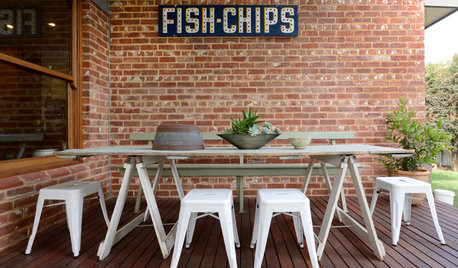Ellie Topp's Caponata, quick advice needed!
michelelc
13 years ago
Related Stories

CONTAINER GARDENS3 Steps to Creating Quick, Easy and Colorful Succulent Containers
Take a bright container, add a colorful succulent or two and have a professional, summery design in minutes
Full Story
TRANSITIONAL HOMESHouzz Tour: Classic American Bungalow Style for a Bachelor
For this homeowner’s first house, a designer creates a clean, neutral look with pieces he can carry into the future
Full Story
HOUZZ TOURSHouzz Tour: High Contrast Shakes Up a Townhouse
A tight budget and a run-of-the mill space didn’t stop two designers from whipping up chic interiors
Full Story
DECORATING GUIDESStaging vs. Decorating: What's the Difference?
Unlike decorating, staging your home isn't about personal style — it's about creating ambiance and appeal for buyers
Full Story
MATERIALSKitchen Ideas: How to Choose the Perfect Backsplash
Backsplashes not only protect your walls, they also add color, pattern and texture. Find out which material is right for you
Full Story
REMODELING GUIDESDesign Workshop: Is an In-Law Unit Right for Your Property?
ADUs can alleviate suburban sprawl, add rental income for homeowners, create affordable housing and much more
Full Story
DESIGN DETAILSThe Secret to Pocket Doors' Success
Pocket doors can be genius solutions for all kinds of rooms — but it’s the hardware that makes all the difference. See why
Full Story
GARDENING AND LANDSCAPINGBudget Decorator: 10 Ways to Deck Out Your Patio
Hang a vintage sign here and some inexpensive curtains there, for a patio or deck that looks polished and pulled together
Full Story
LANDSCAPE DESIGN5 Reasons to Consider a Landscape Design-Build Firm for Your Project
Hiring one company to do both design and construction can simplify the process. Here are pros and cons for deciding if it's right for you
Full Story
MOST POPULAR11 Reasons to Paint Your Interior Doors Black
Brush on some ebony paint and turn a dull doorway into a model of drop-dead sophistication
Full Story





digdirt2
michelelcOriginal Author
Related Professionals
Severn Landscape Architects & Landscape Designers · Signal Hill Landscape Architects & Landscape Designers · Bristol Landscape Contractors · Chelmsford Landscape Contractors · Columbine Landscape Contractors · Longmont Landscape Contractors · Peachtree City Landscape Contractors · Ronkonkoma Landscape Contractors · Suitland Landscape Contractors · Shenandoah Landscape Contractors · Albany Roofing & Gutters · Orlando Roofing & Gutters · Manassas Roofing & Gutters · Miami Beach Roofing & Gutters · Fremont Driveway Installation & Maintenanceskeip
kayskats
cindy-6b/7a VA
aunt-tootie
michelelcOriginal Author
kayskats
skeip
aunt-tootie
michelelcOriginal Author
readinglady
readinglady
digdirt2
michelelcOriginal Author
readinglady